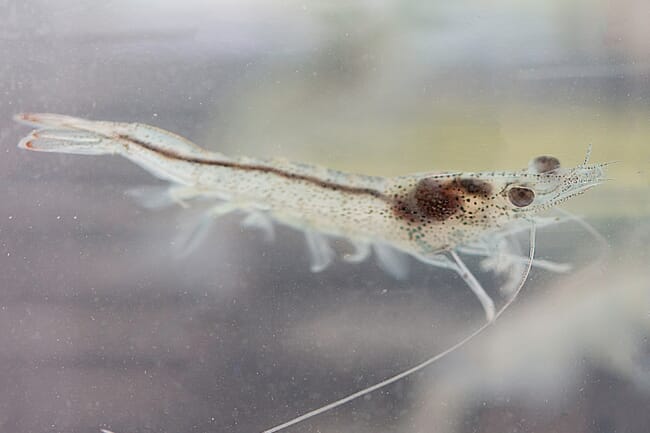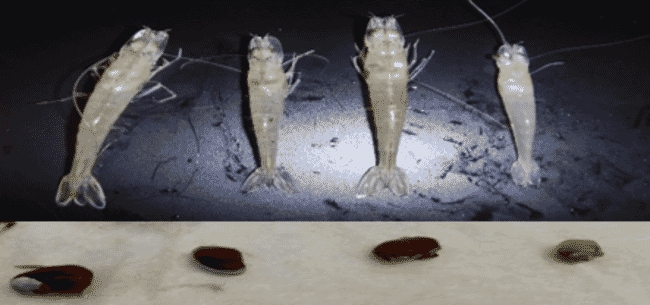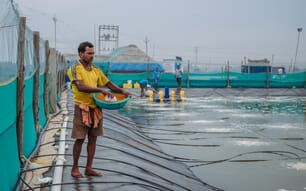
During July 2020 I bought 1000 tilapia fingerlings of about 10 g each from a local hatchery in Panama to stock into cages in my shrimp pools. After a brief acclimation, having been transported for about an hour in bags with water and oxygen, the tilapia were stocked into a small tank at a density of 1,000 fish per m3.
All the fish appeared to be in good shape and all key water quality parameters (nitrogen, pH, alkalinity and total dissolved solids) were perfect. However, the following morning I noticed a few mortalities, with some fish bloated and swimming at the surface. Over the course of the next few days the fish were dying at a rate of about 5 percent per day until I collected the remaining fish and restocked them into a pool that reduced the density to 120/m3. A few days after this, all mortality ended and, when fish were harvested after another month, there were about 400 remaining. I had bought fingerlings from this hatchery a few years previously with 100 percent survival and, as tilapia are so tough that “you can’t kill them with a hammer”, I found this experience more than a little disconcerting.
As all water quality parameters were still perfect, I thought the problem was likely a bacterial infection, as the survivors were able to contend with a lower concentration of infectious bacteria. The same thing happens in cages where fish are chronically dying and, once they are let out of the cage, all mortality stops. A cursory search on the internet yielded adequate information regarding Streptococcus infections causing similar mortality, and this disease was rampant all over the world. Panama hatcheries had obviously changed.
Mass shrimp mortalities
Two months later I had a worse experience when buying shrimp from a hatchery about five hours away by car. This time, after a textbook acclimation, all 100,000 post-larvae were dead within 48 hours. A few samples were preserved for analysis. A few weeks later, I managed to buy a second batch of shrimp from a different hatchery and after a perfect acclimation, I noticed regular 5-10 percent mortality, every day for five days, before all shrimp were removed and placed into another tank at a tenth of the density.
Once again, most mortalities ceased and shrimp began growing at a faster than normal rate, likely due to the decreased densities. This rate of mortality would be very similar to what I experienced with the tilapia previously. The exception here was that shrimp mortalities continued at a very low rate, of less than 1 percent per day. I was not sure of the cause of the post-larvae mortalities. My farm in Panama had been tested for all known shrimp pathogens in October of the previous year by a certified shrimp disease lab. Shrimp samples taken from every pool and all shrimp were found to be negative for all shrimp disease, with the exception of the Infectious hypodermal and haematopoietic necrosis (IHHN) virus, which has been endemic in Panama for decades and is not known to cause any problems.

Clinical signs of vannamei shrimp experimentally infected with three different isolates of V. parahaemolyticus. The shrimp on the left shows a normal colour in the hepatopancreas and the shrimp on the right shows a pale discoloration on the hepatopancreas and an empty stomach, typical signs of AHPND-infected shrimp. © Prof DV Lightner
During February 2021, I contacted the Autoridad de Recursos de Acuaticos de Panama (ARAP) in order for them to come and collect samples to identify any disease present. I knew that acute hepatopancreatic necrosis disease (AHPND) - also known as early mortality syndrome (EMS) - was rampant in Panama, but I did not expect hatcheries to knowingly sell me diseased post-larvae. I collected 10 more shrimp of two sizes for analysis, and the problem was later confirmed to be AHPND by a certified shrimp disease lab. I had bought post-larvae from hatcheries here in Panama for seven years from the period of 2010 to 2017, when they had been classified as specific pathogen-free (SPF), and I never had a problem with disease for over 20 shipments. In fact, I had never had any problems with disease during my entire 25 years of experience in aquaculture in five countries, as my systems were all biosecure. However, this time it was very different, Panama's hatcheries had definitely changed.
Calling in the experts
When looking at similarities from other first-hand accounts about AHPND, I found reports stating that 80 percent mortality is typical of early mortality syndrome (EMS) and that post-larvae from different hatcheries had different rates of survival. It is well-known that hatcheries run two lines of shrimp normally – one with high growth and the other that is disease-resistant. One that can survive and grow fast in a totally biosecure system and another strain that is stocked into ponds and expected to survive against various pathogens found there. At this point I turned to the world authorities on shrimp disease. I contacted the director of the aquaculture pathology laboratory at the University of Arizona, Dr Arun Dhar, and I managed to secure an interview with him and his colleague, Dr Fernando Aranguren.
According to Dr Dhar, EMS was originally associated with a specific strain of the bacteria Vibrio parahaemolyticus. The disease associated with this bacterium originally emerged in China during 2009 and steadily spread across Asia and then to the Americas.
The bacteria release a binary toxin that causes damage or death of tissue (necrosis) to the shrimp hepatopancreas, leading to mortality. According to Dr Dhar, what separates these Vibrio bacteria from other Vibrio
bacteria normally found in aquatic environments is a binary toxin gene found in the genetic code which produces a lethal toxin. Interestingly, sometimes AHPND-causing Vibrio might be present in a system but may not release enough toxin to cause mortality in shrimp. So where did the gene producing the poisonous toxin come from?
“No one really knows where the gene came from, this toxic gene is not normally found in the genome of the associated Vibrio bacteria,” said Dr Dhar. More recently the gene that produces the toxicity was found in other Vibrio species.
“They have even characterised a Vibrio parahaemolyticus strain that carry the genes that encodes the binary toxin gene but does not produce the toxin (which is protein in nature), it does not produce toxins in the same amount that causes such rapid, high rates of mortality,” Dr Dhar explained.
“The binary toxin gene that causes the production of the toxin is plastic and motile and can move around the genome of Vibrio species. There are also transposable genetic elements flanking the binary toxic gene that likely renders its more mobile among Vibrio species”.
“At low levels of bacteria in the water, lower levels of toxins are produced,” Dr Aranguren added.
According to Dr Aranguren, there seems to be quorum sensing going on initiating toxin production, as the level of bacteria increase to a certain level, the bacteria as a population, signal as a whole to release toxins. At a low bacterial level perhaps the binary toxin gene is not activated as much and hence less toxin is produced. This means no mortality. Normally, when this bacteria is present in an intensive aquaculture system, there is mortality within 12 hours.
Dr Aranguren said that EMS is present in some Latin American countries and only causes chronic, rather than acute, mortality. It is likely that the shrimp have developed a resistance/tolerance to the Vibrio bacteria, so that the condition does not result in necrosis of the hepatopancreas.
“The most likely way that the disease enters farms is through live post-larvae shrimp or broodstock. The only real way to prevent the disease is through screening all incoming post-larvae with histology and PCR analysis and engage in strict quarantine practices,” he added.

H&E (Mayer–Bennet hematoxylin and eosin-phloxine) histology of a healthy (left) and an AHPND-infected (right) SPF shrimp displaying an acute phase infection. In the infected animal (Right panel), sloughing of epithelial cells in the lumen of hepatopancreatic tubule, leading to collapse of the tubule. Scale bars= 100 μm. (Click on image to enlarge).
Applying the experts’ advice
So, how do shrimp post-larvae survive in hatcheries and then quickly die when placed in biosecure facilities that have been tested and shown to be disease-free over many years?
As shrimp hatcheries are always tight-lipped about protocols and techniques used to produce post-larvae, it was hard to ascertain precisely what had happened in my case. However, it is not hard to present a very plausible scenario – the hatcheries could have engaged in intensive water exchange with sterile water, probiotics, antibiotics and expensive immunostimulant ingredients in feeds that allowed the post-larvae to tolerate the lower Vibrio counts, along with the lack of excessive amounts of toxins produced through quorum sensing. Once the post-larvae enter the “jungle” of an intensive system with high solids, low level nitrogen and a favourable “vibrio type” environment, they quickly die.
Is there a remedy?
“There is no therapy against AHPND, once the disease is introduced in a farm, there could be high mortality in shrimp that have not been previously exposed to the disease, especially when the conditions are favourable for Vibrio growth,” says Dhar.
According to both of these shrimp disease experts, the only remedy for AHPND is to start over with total biosecurity, or try to reproduce shrimp that have an inherent ability to survive the bacterial infection. Normally fast growing shrimp do not possess bacterial resistance, so selection for survival means lower growth rates. Unlike most viruses, these bacteria can survive for extensive periods of time without a host, which makes them much harder to eradicate than viruses.
Dr Aranguren says that it has been shown in trials in Ecuador that adding another similar bacteria, which occupies a similar ecological niche in the system, may outcompete the infectious bacteria and this can limit the possibility of infection to the shrimp.
“Another possible way to contend with the [Vibrio] bacteria is by adding organic acids to the feeds to produce a greater acidity (lower pH) in the digestive tract, so as to limit the ability for the bacteria to grow and reproduce in the shrimp. So, in essence, by adding organic acids to feeds, it may increase the ability to withstand bacterial infection,” he explains.
When will these hatcheries recover? Likely not for years – once hatcheries have an infection of this magnitude, components need to be completely disassembled, sterilised, dried and rebuilt. Broodstock have to be selected for disease resistance and, if possible, disinfected and bred for generations until a bacterial resistant strain is developed, so that it can adequately survive AHPND. Once this has been accomplished, re-obtaining certification for SPF status will not be so easily done. Beyond this, hatcheries will have to rebuild trust among growers.
I was building a hatchery for tilapia and shrimp but – between my teaching, writing and other business – I’ve not yet had time to finish it. I know that Panama’s hatcheries are just not the same anymore and I am looking forward to closing the loop and engaging in complete vertical integration and establishing full biosecurity, at my own farm – this time for good.


